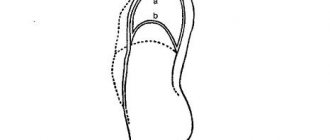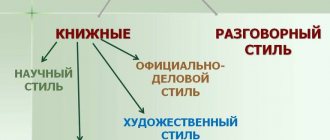The sound [l] normally appears in a child at the age of 5 years. But the sound [l'-l] normally appears independently earlier from 3 years. If a child at 5 years old does not have the sounds [l], [l'], be sure to contact a speech therapist. If in a child’s speech the sounds [l], [l'] appear in a distorted version (maybe even earlier at 3 or 4 years), contact a speech therapist as soon as you notice it. Distorted sounds are never restored on their own.
How to pronounce the sound [l].
- teeth are brought together to a distance of 2-4 mm;
- neutral lip position;
- a weak stream of air passes along the sides of the tongue;
- vocal folds are closed - produce voice.
- the tip of the tongue is raised and pressed against the base of the upper incisors;
- the lateral edges of the tongue do not meet the molars;
- the back of the tongue is raised towards the soft palate;
- the root part is raised - “saddle”;
- the back of the tongue is lowered.
Articulatory features of the sound [l].
[l] – mouth sound. The soft palate is raised, the uvula is pressed against the back wall of the pharynx, air enters the oral cavity; [l] – consonant sound. The air escaping from the oral cavity encounters a barrier; [l] – ringing sound. When pronouncing the sound [l], the vocal cords are closed, vibrate, and a voice is formed; [l] – stop-pass sound according to the method of formation. The tip of the tongue forms a connection with the alveoli or upper teeth, the air stream passes along the sides of the tongue, between the tongue and the cheek; [l] – anterior lingual sound at the place of formation. A barrier to the outgoing air stream is formed by the front part of the back of the tongue.
Acoustic signs of sound [l].
[l] – sonorant (sonorous) sound – its quality is determined by the nature of the sound of the voice, which plays a major role in the formation of sound, and noise participates to a minimal extent; [l] - hard sound - the middle part of the back of the tongue does not take an active part.
Sound disturbances [l].
- The sound [l] is absent in the child’s speech - lambdacism.
- The sound [l] is replaced - paralambdacism: - with [a], [u], [s] and other vowels; — on [l'] – softening; — on [c] – labiodental paralambdacism; - on [n] – lingual-dental paralambdacism; - on [g] – posterior palatal paralambdacism; - on [th] - midpalatal paralambdacism.
- The sound [l] is distorted: - nasal pronunciation (nasal lambdacism); - interdental pronunciation (interdental lambdacism).
How to pronounce the sound [l'].
When pronouncing the sound [l'], the position of the organs of articulation is similar, but:
- lips are open, stretched more to the sides;
- the back of the tongue rises a little higher towards the hard palate and forward, and the back of the tongue is moved forward and lowered.
Articulatory features of the sound [l'].
[l'] – consonant sound. The air escaping from the oral cavity encounters a barrier; [l'] – mouth sound. The soft palate is raised, the uvula is pressed against the back wall of the pharynx, air enters the oral cavity; [l'] – ringing sound. When pronouncing the sound [l'], the vocal cords are closed and tremble, a voice is formed; [l'] – anterior lingual sound at the place of formation. The barrier to the outgoing air stream is formed by the front part of the back of the tongue; [l'] – stop-passive sound according to the method of formation. The tip of the tongue forms a bridge with the alveoli or upper teeth, the air stream passes along the sides of the tongue, between the tongue and the cheek.
Acoustic signs of sound [l'].
[l'] - soft sound - the middle part of the back of the tongue is additionally raised towards the hard palate; [l'] - sonorant (sonorous) sound - its quality is determined by the nature of the sound of the voice, which plays a major role in the formation of sound, and noise participates to a minimal extent.
Sound disturbances [l'].
- The sound [l'] is absent in the child’s speech - lambdacism.
- The sound [l'] is replaced - paralambdacism: - with [a], [u], [s] and other vowels; - on [c'] – labiodental paralambdacism; - on [n'] – lingual-dental paralambdacism; - on [g'] – posterior palatal paralambdacism; - on [th] - midpalatal paralambdacism.
- The sound [l'] is distorted: - nasal pronunciation (nasal lambdacism); - interdental pronunciation (interdental lambdacism).
Sounds of the Russian language
Our speech consists of words that are combined into a sentence. Each word can be considered as a semantic component of a sentence, filled with content, and also as a sounding object.
A word can be divided into syllables, which are made up of individual sounds. From a phonetic point of view, a word is made up of sounds.
Sound is the basic unit of language, just like words and sentences. Sounds form words at the phonetic level. Sounds, depending on their set, quantity, and location in a certain sequence, help to distinguish one word from another:
- treasure - contribution;
- crown - crown;
- cat - current.
Depending on how sounds are formed in the speech apparatus, vowels and consonants are distinguished in the Russian language.
The vowel sounds [a], [o], [e], [u], [i], [s] consist entirely of voice. When they are formed, air passes freely through the tense vocal cords and mouth, without encountering any obstacles on its way. In Russian, vowel sounds are musical. You can drag them out for a long time and sing: a-a-a, o-o-o, o-o-o.
Vowel sounds form a phonetic syllable in a word, but consonants cannot form it. When syllabled, they are combined with vowel sounds in pairs or whole groups:
- collar - collar;
- beauty - beauty.
Pronunciation problems
Defects
in
children, problems
associated with incorrect reproduction
of hard
“L” and soft “L” are usually divided into 2 large groups.
Presented in the table
:
| Group name | Type of deviation | Characteristic |
| Lambdacism | Nasal. | The child pronounces a sound with incorrect breathing. The air flow will enter the nasal passages. (“L” is replaced by “NG”). |
| Bilabial. | During pronunciation, the baby involuntarily makes a straw with his lips. It turns out that “L” is replaced with “U” (varnish with Uak; summer with Ueto, etc.) | |
| Interdental. | The tip of the tongue ends up in the interdental space. | |
| Absence of a letter in a conversation. | The child completely excludes the letter from the vocabulary (the lamp changes to Ampa). | |
| Paralambdacism (changes the phoneme to other sounds) | Replacing "L" with "V". Paw - Vapka; Moon - Vuna. | |
| Replacing "L" with "G". Chair – Stug; Meadow - Gug. | ||
| Replacing "L" with "D". Line - Desk; Fox - Dis. | ||
| Replacing the hard “L” with a soft one. Dala - Dalia. | ||
| Replacing “L” with “YA”, “Yo”, “YU”. Paw - Yapka; Spoon - Yozhka; Love - Yubov. | ||
Expert opinion
Margarita Sergeevna S.
Speech pathologist and speech pathologist with 15 years of experience working in various speech correction centers with children of different ages.
Any of the listed types of deviations can be eliminated with the help of speech therapy exercises and techniques.
The process of working on sound [L]
If the pronunciation of several phonemes is defective, as well as if speech disorders occur in adulthood after suffering stress or injury, it is necessary to seek qualified help from a speech therapist. If an adult pronounces only one or two phonemes incorrectly, he can cope with the speech problem on his own at home, without the help of a specialist.
The process of eliminating defective pronunciation of any sound consists of four stages: preparatory, production itself, automation, differentiation.
You cannot skip a stage and move on to the next one without completely mastering the previous one.
Preparatory exercises for sound [L]
The preparatory stage serves to create the correct articulatory position. It involves performing special speech therapy exercises. To correctly reproduce the sound [L], it is important to raise the tip and back of the tongue, learn to relax the lateral edges and make a targeted exhalation.
To practice lifting the tip of the tongue, the following exercises are used:
- Open your mouth, lips are not tense, a relaxed tongue is quickly placed first on the upper lip, then on the lower. Gradually complicate the action by moving the tongue into the mouth, fixing it at the alveolar processes.
- Open your mouth. Using a flat tongue, lick the relaxed upper lip, moving from top to bottom, then hide the tongue towards the middle of the palate.
- Smile and open your mouth. Press your flat tongue against the upper alveoli and loudly tear away. Start slowly, gradually accelerating.
- Smile with your mouth open. Use the flattened edge of your tongue to slap your upper lip back and forth, trying not to separate your tongue from your lip. Start performing actions slowly, gradually pick up speed and connect the vocal cords, achieving the combination [Bl-bl].
- Tighten the bent tip of your tongue and move it back and forth across the palate at different speeds. The interdental space is equal to the thickness of a finger. The lips open slightly and do not touch the incisors. The jaws are static.
Raising the back of the lingual back is practiced by singing the vowel phonemes [O], [U], [A], [Y]. To train the skill of lowering the sides of the tongue and purposefully exhaling a stream through the gap between them and the molars, you need to tightly hold the flat tip of the tongue with your teeth, exhale air, puffing out your cheeks, and at the same time lightly tap them with your fingers to make a squelching sound.
When the articulatory organs are ready and the exercises can be performed flawlessly, at a fairly rhythmic pace, you can start setting up the sound.
Methods for producing the sound [L] in adults
The production of the [L] sound in adults is carried out using the same methods as in children; the choice of technique depends on the mechanism of the defect.
Staging sound in the event of its absence is possible in three ways:
- From the reference phoneme [A]. Place the flat edge of the tongue on the lower lip and lightly press it with the incisors. The tongue is motionless. Do it multiple times. Then you need to extend the sound [A] at the moment of biting your tongue, gradually increasing the speed. The syllables AL and LA should be heard. After receiving the necessary syllables, move the tongue behind the teeth to the correct position for articulation [L].
- Mechanically from the reference phoneme [U]. Place your tongue between your outstretched lips. Stretch [U], at the same time separate the lips with your fingers, moving them towards the front wall of the incisors.
- From the reference phoneme [ы]. The production is performed in the same way as from the phoneme [A].
Similar methods of setting [L] are used for interdental [L] and when replacing it with phonemes [Y] and [G]:
- With nasal lambdacism, it is necessary to achieve precise movement of the air flow: the air should be exhaled through the mouth.
- When replacing [L] with the phoneme [Y], one must learn to hold the tip of the tongue, pressing it firmly against the upper incisors, and relax the middle of the lingual back, lifting the root. In order for the tongue to take this position, you need to place the flat tip on the lower incisors and stretch [Y] or place a round object in the middle of the tongue, lifting the tip of the tongue to the upper alveolar process.
- When replacing with [U], you should achieve a static state of the lips.
- If there is a replacement for [B], the activity of the lower lip must be eliminated. To do this, you must first learn to lower it, opening the incisors, and hold it in this position, then raise the tongue to the upper molars. Do it repeatedly. If you can’t do it correctly, you can place a tense finger under your lower lip and help them.
The performance is completed when the person can pronounce the sound in isolation.
Automation and differentiation of sound [L]
Correct pronunciation of a sound requires mandatory automation, that is, consolidation in spontaneous speech. It should begin with pronouncing forward and backward syllables. At first, you need to speak the syllables slowly, drawing out each sound. This helps the speech organs take the correct position. The speed of pronouncing syllables gradually increases, approaching the usual rate of speech. After successfully pronouncing a sound in syllables, you can automate it in words and then in sentences. Automation is positively influenced by memorizing poems rich in fixed sound, retelling and composing texts.
The final step in working on sound pronunciation is the stage of differentiation. This is the discrimination of phonemes that are similar in articulation and sound. At this stage, a person learns not to replace them in speech and not to confuse letters in writing. This is most important for those who have previously experienced paralambdacity.
Differentiation, by analogy with automation, begins with the distinction of phonemes in syllables, then proceeds to words and phrases. When differentiating, it is important to use tongue twisters. After the final stage, children freely use the correct sound in their own speech. But an adult may take much longer due to too much mispronunciation.
Thus, you can learn to correctly speak the sound [L] to an adult on your own in the absence of other speech problems. The difficulty is that self-control will be required for quite a long time. It is needed in order to eliminate the existing automatic skill of incorrect pronunciation.
Diagnostics
The task of determining the causes and type of lambdacism is implemented during speech therapy diagnostics. If it is necessary to clarify the medical aspects of the pathology, consultations with a pediatric dentist, maxillofacial surgeon, neurologist, or otolaryngologist are prescribed. To study speech status, the following is carried out:
- Examination of peripheral speech organs.
The speech therapist visually assesses the structure of the tongue, palate, lips, and pays attention to muscle tone. The child is asked to perform certain exercises that allow him to judge the mobility of the speech organs, the accuracy and switchability of movements. As part of such an examination, possible causes of lambdaism are established and a diagnostic hypothesis is put forward. - Analysis of phonemic hearing.
Necessary for the purpose of differentiating lambdacism and paralambdacism. To test speech hearing, speech therapy techniques of repetition, naming, and demonstration are used. Phoneme discrimination is tested in syllables and words. - Assessment of the phonetic side of speech.
At this stage, the pronunciation of all sounds is checked: the type of lambdaism is determined, and accompanying sound defects are identified. Based on the examination results, a plan and sequence of correction are outlined.
Articulation gymnastics
Consonants
Consonant sounds constitute a larger group of the phonetic structure of the Russian language. There are 36 of them. Compared to vowels, consonant sounds have a different quality. They are pronounced muffledly and are formed with little participation of the voice, which is necessarily accompanied by noise. Noise occurs if, when pronouncing a consonant sound, a stream of air encounters an obstacle in the form of a raised tongue, rubs against the walls of the cheeks, as a result of closing and opening the lips, etc. Definition Consonant sounds are sounds in the formation of which noise is involved.
According to the degree of participation of voice and noise, consonant sounds are divided into sonorant and noisy .
Sonorant sounds are sounds in which noise is minimal and the voice predominates.
Let's list the sonorant sounds: [l], [l'], [m], [m'], [n], [n'], [r], [r'].
According to the relationship between voice and noise, noisy consonants are also divided into two groups:
- voiced consonants;
- voiceless consonants.
Voiced consonants
Compared to sonorants, in voiced consonants, during their formation, noise prevails over voice. In Russian, the following sounds are voiced: [b], [b'], [v], [v'], [g], [g'], [d], [d'], [zh], [z] , [z'].
They are paired based on hardness and softness:
- [b] - [b']
- [in] - [in']
- [g] - [g']
- [d] - [d']
- [z] - [z'].
Only the voiced consonant [zh] is always hard and has no pair for softness:
- millstone [z o r n o f]
- lived [lived].
Voiceless consonants
Only noise is involved in the formation of voiceless consonant sounds. In the phonetics of the Russian language, 16 voiceless consonants are distinguished. Letters denoting unvoiced sounds are found in the second half of the Russian alphabet. Let's list the voiceless consonant sounds: [k], [k'], [p], [p'], [s], [s'], [t], [t'], [f], [f'], [x], [x'], [ts], [h'], [w], [w'].
Most voiced and unvoiced sounds are pairs that match in other phonetic characteristics. There are 11 such pairs of consonants, differing only in terms of voicedness/voicelessness:
- [b] - [p]
- [b'] - [p']
- [v] - [f]
- [v'] - [f']
- [g] - [k]
- [g'] - [k']
- [d] - [t]
- [d'] - [t']
- [f] - [w]
- [z] - [s]
- [z'] - [s'].
Only five noisy voiceless consonants [x], [x'], [ts], [ch'], [sh'] do not have paired voiced consonants.
Paired voiced
There are 20 voiced sounds in the Russian language, and they are designated by 11 letters. In turn, they are divided into paired and unpaired. Paired voiced ones are:
- [b] - boot [bat'inak], beet [bur'ak], Pinocchio [burat'ina];
- [b'] - to love [l'ub'it'], thrifty [b'ir'izhl'ivy'], advertisement [ab'y'ivl'en'iy'e];
- [v] - driver [vad'it'il'], lie [vrat'], beer [p'iva];
- [v'] - wreath [v'inok], see [uv'id'it'], deja vu [d'izhav'u];
- [g] - race [race], deafening [audushyt'il'nyy'], warm [sagr'et'];
- [g'] - coat of arms [g'erp], garland [g'irl'an'da], hero [g'erai'];
- [d] - long [dl'in:y'], wait [padazdat'], soul [soul];
- [d'] - duchess [d'ushes], village [d'ir'evn'a], lonely [ad'inok'iy'];
- [z] - gold [zolata], St. John's wort [z'irobay'], belly [pusa];
- [z'] - strawberry [z'iml'in'ika], earth [oz'im'], winter [z'ima];
- [zh] - leather [leather'], acorn [zholut'], rozhon [razhon].
These consonants are called paired because there are dull sounds that sound similar to them - only with less voice and more noise. These are the sounds [p], [p'], [f], [f'], [k], [k'], [t], [t'], [s], [s'], [sh] . Try to pronounce the sound from the previous list and this list alternately and you will immediately understand what we are talking about.
Causes of impaired sound pronunciation in adults
Most often, impaired sound pronunciation in adults is the result of speech problems that were not eliminated in childhood. As a rule, a speech disorder is accompanied by low tone and slight incoordination of the articulatory organs: tongue, lips, jaws.
Various anomalies in the structure of the speech apparatus are often noted: an incorrectly formed bite, a short hyoid ligament, an inflated or narrow palatine vault. They can be diagnosed by a dentist or orthodontist. Also, the state of speech is affected by factors such as deterioration of physical hearing and neurological problems. Speech problems can occur due to injury or severe stress.
Methods for making the sounds L and L
What sound can you make the sound L from?
determined individually for each child, taking into account capabilities and skills. In speech therapy practice, the following methods are distinguished:
- By imitation. Performed while sitting in front of a mirror. The baby is shown the correct location of the speech organs in the reflection and asked to repeat. After a successfully completed task, they are asked to sound out the letter in this position.
Note: the lesson is most suitable for children with a complete absence of phonemes in words, when there is no need to rearrange the established positions of organs during reproduction.
- Setting from the letter “Y”. Occurs in a playful way, simulating a steamship. The baby is asked to smile broadly. Lightly bite your tongue and pronounce the sound “Y” in a drawn-out manner. It will smoothly turn into a drawn-out l-l-l. You can try this exercise with other vowel sounds.
- Setting from the letter "B". The lesson is aimed at inhibiting the lower lip. When pronouncing the letter “B”, the baby should not move his lower lip. If it doesn’t work, the adult holds the sponge with his finger. For preschoolers
, they read special
poems
or sing
songs
with an abundance of the letter “L” in the words and ask them to repeat. - Production from the sound “L”. A soft sound is pronounced more readily by a child. It does not require tongue tension and is faster. To get a solid phoneme, the baby is asked to reproduce syllables
(La, Lo, Lu). At the same time, they are asked to reach the upper lip with the tip of their tongue. - Mechanical method. Performed using a special tool or clean fingers. Carry out the manipulation only under the supervision of a speech therapist or with his participation. The tongue is asked to be lifted by the upper incisors. The instrument maintains it at the desired level during pronunciation of the phoneme. The method is suitable for patients with dysarthria.
Expert opinion
Margarita Sergeevna S.
Speech pathologist and speech pathologist with 15 years of experience working in various speech correction centers with children of different ages.
The above methods can be performed one at a time or several can be used at once. All the secrets
You can learn how to perform the techniques during a consultation with a speech therapist.
Exercises for the speech apparatus
Articulation gymnastics —
the most important component of successfully overcoming
pronunciation
deficiencies Completing tasks
with an emphasis on the speech organs is
a preparatory stage
before setting the phoneme. Basic exercises for training the mobility of the lips and tongue:
- Hammock . Use the tip of your tongue to touch your upper teeth. The rest of the organ is bent downwards, forming a hammock. Stay in this position for 10-15 seconds.
-
. Move the wide tongue first along the upper, then along the lower lip. In this case, the lips should be motionless.
Delicious jam - Turkey . The tongue licks its lips at an accelerated pace. At this time, the child should try to say bl-bl-bl-bl.
Horse.
The baby is asked to imitate the clicking of an animal's hooves. The tip of the tongue flicks the roof of the mouth.- Wide smile.
The baby is asked to stretch his lips into a smile as far as possible and freeze in this position for a few seconds. The exercise will be repeated 2-3 times.
Note: classes help train articulation
if it is difficult to place any types of phonemes - voiceless or voiced , hard or soft, etc.
Breathing exercises
The sounds “L” and “L” are produced as you exhale. To correctly place the phoneme, experts recommend regularly performing inhalation-exhalation exercises:
- Stop, horse! Take a deep breath, and as you exhale say br-br-br.
- Ball.
The baby is asked to lie down on the floor. Hands are placed on the tummy. As you inhale, the “ball” (tummy) inflates, and as you exhale, it deflates. - Ship. A paper boat is lowered into a basin of water. The baby is offered to move it with a stream of air.
Breathing exercises are performed for 2-3 minutes daily.
Advice: a detailed
work plan and more detailed methods of training the speech organs are provided by a speech therapist. The specialist will explain how to quickly and effectively carry out the exercises.








